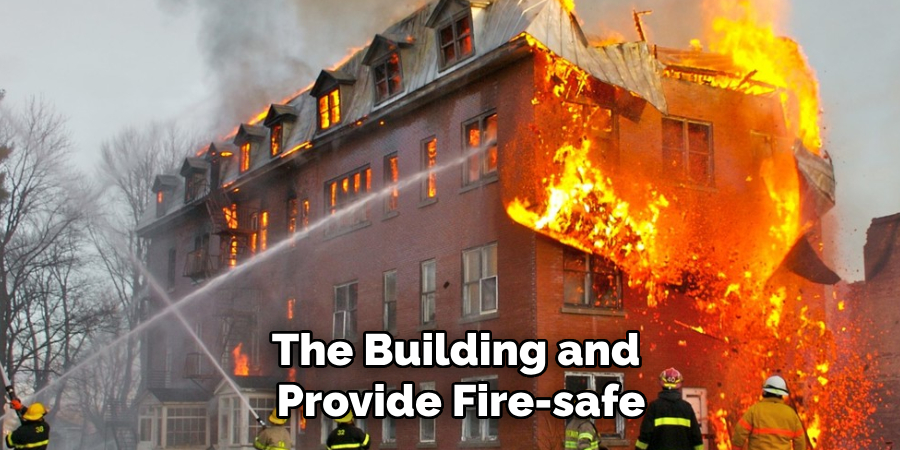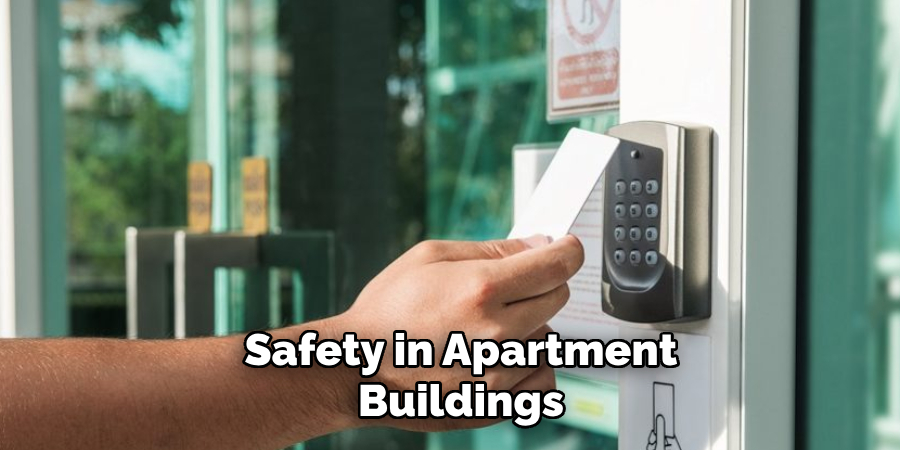Fires in apartment buildings can be devastating, causing not only property damage but also endangering lives. Preventing these incidents requires everyone to take proactive measures and understand common fire risks. By following proper safety practices, educating residents, and maintaining the building’s fire protection systems, it is possible to significantly reduce the risk of fires and ensure a safer living environment for all.
This guide will outline key steps for how to prevent fires in apartment buildings.

Common Causes of Fires in Apartment Buildings
Understanding the common causes of fires in apartment buildings is crucial for prevention. One major cause is unattended cooking, which can lead to grease fires or other accidents in the kitchen. Electrical malfunctions, such as overloaded circuits, faulty wiring, or the misuse of extension cords, are another significant source of fire hazards. Smoking indoors is also a frequent contributor, especially when cigarette butts are improperly disposed of.
Additionally, the improper use of space heaters or leaving them too close to flammable objects can ignite a fire. Finally, negligence in handling candles, matches, or other open flames poses a persistent risk. By identifying these causes, building managers and residents can take targeted steps to mitigate potential dangers.
10 Methods How to Prevent Fires in Apartment Buildings
1. Install and Maintain Smoke Detectors
Smoke detectors are the first line of defense against fires. Ensure that every apartment unit and common area has functioning smoke detectors installed. Test the devices monthly and replace batteries at least once a year. Encourage tenants to report malfunctioning detectors and provide instructions for regular testing. Building management should also conduct periodic checks to confirm that all smoke detectors are operational.
Working smoke detectors can provide early warning, giving residents more time to evacuate and reducing the likelihood of fatalities.
2. Create and Enforce No-Smoking Policies
Smoking is one of the leading causes of apartment fires. To mitigate this risk, implement and enforce strict no-smoking policies within the building, especially in common areas and near flammable materials. Designate outdoor smoking areas far from the building and provide fire-safe receptacles for cigarette disposal. Educate residents about the dangers of smoking indoors and the importance of following safety protocols.

A clear no-smoking policy can significantly reduce the chances of accidental fires caused by discarded cigarette butts.
3. Ensure Proper Electrical Safety
Electrical malfunctions are a common cause of fires in apartment buildings. Regularly inspect the building’s wiring and electrical systems to identify potential hazards such as frayed wires, overloaded circuits, or faulty outlets. Encourage tenants to use power strips with surge protectors and avoid overloading outlets. Provide guidelines on safely using electrical appliances, including unplugging devices when not in use.
Addressing electrical issues promptly can prevent sparks that may ignite a fire.
4. Install Fire Extinguishers and Train Residents
Fire extinguishers are essential for suppressing small fires before they escalate. Place extinguishers in easily accessible locations, such as hallways, stairwells, and kitchens. Label their locations clearly and ensure they are inspected and maintained regularly. Offer fire extinguisher training sessions for residents and staff so they know how to use them effectively.
Educating residents about the PASS method (Pull, Aim, Squeeze, Sweep) can empower them to respond quickly and safely during a fire emergency.
5. Promote Safe Cooking Practices
Cooking is a leading cause of apartment fires, often resulting from unattended stoves or unsafe practices. Educate residents about the importance of staying in the kitchen while cooking and keeping flammable items like dish towels and paper products away from heat sources. Encourage the use of timers to avoid forgetting about food on the stove.
Provide guidelines for safely using appliances such as microwaves and toasters. Building management can also consider installing fire-resistant cooking mats or stovetop fire suppressors in each unit.
6. Establish a Fire Safety Plan
A comprehensive fire safety plan is vital for preventing and responding to fires. Develop a plan that includes evacuation routes, designated meeting points, and contact information for emergency services. Post the plan in common areas and distribute copies to all residents. Conduct regular fire drills to familiarize tenants with evacuation procedures.
Clear communication and preparedness can reduce panic during an emergency and ensure everyone knows how to evacuate safely.

7. Maintain Clear Exits and Stairwells
Blocked exits and cluttered stairwells can hinder evacuation efforts and increase the risk of injury during a fire. Enforce rules that prohibit storing items like bicycles, furniture, or trash in hallways and near exits. Regularly inspect these areas to ensure they remain clear and accessible. Illuminate stairwells and exit signs to guide residents during low-visibility situations.
Clear pathways can save precious seconds during an emergency, potentially saving lives.
8. Control Combustible Materials
Improper storage of combustible materials can exacerbate fire hazards. Establish guidelines for safely storing flammable items such as cleaning supplies, paint, or propane tanks. Store these materials in designated areas away from heat sources and electrical equipment. Encourage tenants to declutter their units and dispose of unnecessary flammable items responsibly.
Proper storage and disposal practices can significantly reduce the risk of fires spreading rapidly.
9. Install Fire Sprinkler Systems
Fire sprinkler systems are highly effective in controlling fires before they spread. Work with a licensed contractor to install sprinklers in all units and common areas. Regularly inspect and maintain the system to ensure it remains functional. Sprinklers activate automatically when a fire is detected, suppressing flames and limiting damage.
While the initial installation cost may be high, the long-term safety benefits outweigh the expense, making sprinklers a worthwhile investment for apartment buildings.
10. Educate Residents on Fire Prevention
Awareness and education are key to preventing fires in apartment buildings. Organize community workshops or distribute educational materials on fire safety topics. Topics could include proper use of electrical appliances, safe cooking practices, and recognizing fire hazards. Encourage residents to take proactive measures, such as creating a personal evacuation plan and keeping a fire escape ladder in upper-floor units.
A well-informed community is better equipped to prevent and respond to fire emergencies.
Troubleshooting Common Issues
Even with comprehensive fire prevention measures in place, issues may arise that require immediate attention to maintain safety in apartment buildings. Below are some common problems and ways to address them effectively:

- Malfunctioning Fire Alarms
A fire alarm that fails to sound can put lives at risk. Regularly schedule maintenance checks to test all alarms and replace batteries as needed. Residents should report any beeping or malfunctioning alarms promptly. Ensure hardwired systems are inspected for electrical faults by a licensed technician.
- Blocked Fire Sprinkler Heads
Items like furniture, decorations, or even dust can obstruct sprinkler heads, rendering them ineffective. Conduct routine inspections to clear any obstructions around sprinklers, and educate tenants about keeping these areas accessible.
- Failure to Evacuate During Drills
Some residents may disregard fire drills, leading to unpreparedness in real emergencies. Address this through community meetings that emphasize the importance of participation. Use signage and friendly reminders to ensure drills are taken seriously.
- Overloaded Outlets and Circuits
Overused electrical outlets can spark fires. Regularly inspect units for signs of overloaded outlets, such as scorch marks or warm plugs. Provide tenants with clear guidelines on the safe use of power strips and extension cords. Offer resources for proper electrical safety.
- Non-Compliance with No-Smoking Policies
Enforcing no-smoking policies can be difficult if residents fail to comply. Use clear communication to outline the consequences of violations and consistently enforce the rules. Designated outdoor smoking areas can help reduce indoor infractions.
When to Contact a Professional
While many fire safety measures can be managed internally, certain situations require the expertise of professionals to ensure comprehensive protection. Knowing when to bring in a licensed contractor or specialist can prevent accidents, improve compliance, and maintain the integrity of fire prevention systems. Here are some scenarios where professional assistance is necessary:
- Installation or Maintenance of Fire Protection Systems
Tasks such as installing fire alarms, sprinkler systems, and smoke detectors should always be handled by certified professionals. Regular inspections and maintenance of these systems also require technical expertise to identify and correct potential issues.
- Electrical Inspections and Repairs
Faulty wiring, overloaded circuits, and outdated electrical systems are significant fire hazards. An electrician can evaluate the building’s electrical infrastructure and make upgrades or repairs as needed to ensure safety.
- Fire Code Compliance Assessments
Keeping up with local fire codes and regulations can be complex. A fire safety consultant or inspector can evaluate the building to ensure it meets current codes, helping to avoid fines or penalties while improving resident safety.
- Addressing Hazardous Material Storage
Improper handling or storage of flammable materials like chemicals and fuels can increase fire risks. Consulting with a hazardous materials expert can help establish safe storage protocols and reduce potential dangers.

Conclusion
Preventing fires in apartment buildings requires a combination of proactive measures, regular maintenance, and community involvement. By implementing these ten methods, building managers and residents can work together to create a safer living environment. From installing smoke detectors and sprinklers to promoting fire safety education, every step plays a vital role in minimizing the risk of fire-related incidents.
Thanks for reading our blog post on how to prevent fires in apartment buildings! We hope you found it helpful and informative.
About
Safety Fic is a distinguished figure in the world of Diy design, with a decade of expertise creating innovative and sustainable Diy solutions. His professional focus lies in merging traditional craftsmanship with modern manufacturing techniques, fostering designs that are both practical and environmentally conscious. As the author of diy, Safety Fic delves into the art and science of Safety Fic-making, inspiring artisans and industry professionals alike.
Education RMIT University
(Melbourne, Australia) Associate Degree in Design (Safety Fic) Focus on sustainable design, industry-driven projects, and practical craftsmanship. Gained hands-on experience with traditional and digital manufacturing tools, such as CAD and CNC software.
Nottingham Trent University
(United Kingdom) Bachelor’s in diyfastly.com and Product Design (Honors) Specialized in product design with a focus on blending creativity with production techniques. Participated in industry projects, working with companies like John Lewis and Vitsoe to gain real-world insights.
Publications and Impact
In diy, Safety Fic his insights on indoor design processes, materials, and strategies for efficient production. His writing bridges the gap between artisan knowledge and modern industry needs, making it a must-read for both budding designers and seasoned professionals.
